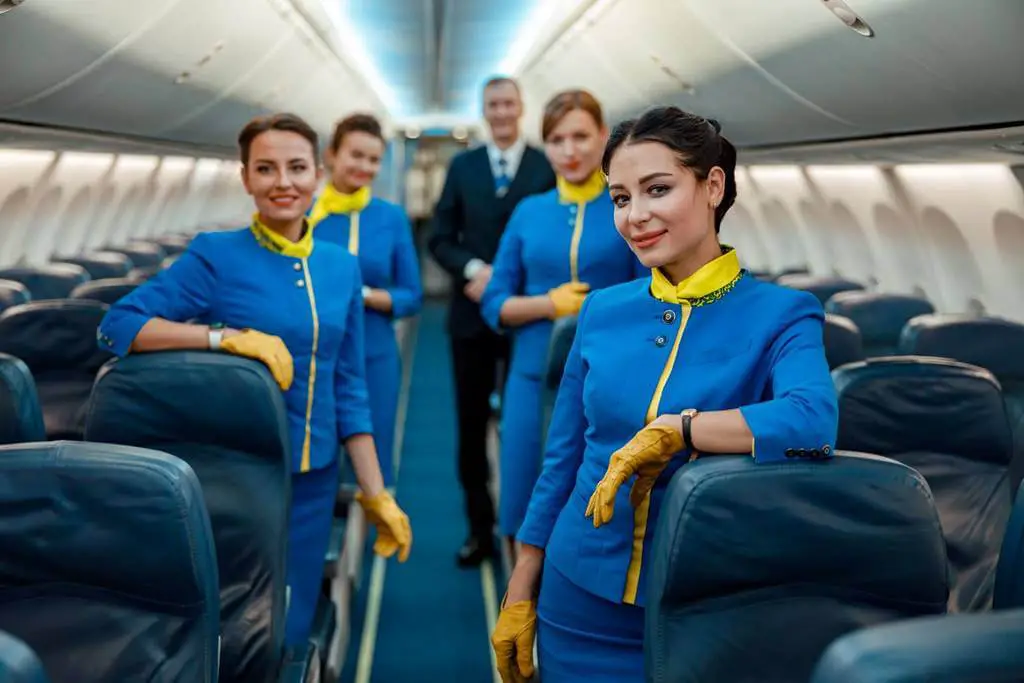How to Become a Flight Attendant

Discover the steps to pursue your dream career in aviation by learning how to become a flight attendant
How to Become a Flight Attendant
In a world where travel is becoming more accessible and frequent, the role of a flight attendant has garnered immense popularity. If you've ever dreamt of traveling the world, meeting new people, and having adventures in the sky, then becoming a flight attendant might just be your dream job. In this comprehensive guide, we will explore the steps, qualifications, and insights you need to embark on this exciting career path.
What does a Flight Attendant do?
Before we delve into the journey of becoming a flight attendant, let's understand what this job entails. Flight attendants are responsible for ensuring the safety, comfort, and well-being of passengers during air travel. They assist passengers in emergencies, provide inflight services, and create a positive travel experience.
Qualification Required to Become a Flight Attendant
Becoming a flight attendant is not as simple as packing your bags and applying for the job. Airlines have specific requirements that candidates must meet. Here are some key qualifications you'll need:
1. High School Diploma or Equivalent
Most airlines require a high school diploma or its equivalent as the minimum educational requirement. Having a college degree can be an advantage, but it's not always mandatory.
2. Customer Service Skills
Excellent customer service skills are essential. Flight attendants interact with passengers daily, so being friendly, patient, and attentive is crucial.
3. Physical Fitness
Flight attendants need to be physically fit to handle the demands of the job. This includes lifting luggage, standing for extended periods, and moving swiftly in confined spaces.
4. Language Proficiency
Proficiency in English is typically required, as it's the universal language of aviation. Knowledge of additional languages can be a significant asset.
Types of Flight Attendant
Flight attendants work in various capacities, and their roles can be categorized into the following types:
Domestic Flight Attendants:
- Domestic flight attendants primarily work on flights within their own country. These flights typically have shorter durations and routes that don't cross international borders.
- They are responsible for ensuring the safety and comfort of passengers during domestic flights, handling inflight services, and providing assistance as needed.
- Domestic flight attendants usually have more frequent trips back to their home base and shorter layovers.
International Flight Attendants:
- International flight attendants work on long-haul flights that often cross time zones and international borders. These flights can cover extensive distances and require longer periods away from home.
- Their responsibilities include not only the safety and well-being of passengers but also handling customs and immigration procedures for international flights.
- International flight attendants typically have more extended layovers in foreign destinations, allowing them to explore new cultures during their downtime.
Corporate Flight Attendants:
- Corporate flight attendants serve on private and corporate jets, catering to high-profile clients, executives, and VIPs.
- Their role goes beyond typical commercial flight duties, as they provide personalized service and cater to specific preferences of the passengers.
- Corporate flight attendants are often responsible for managing inflight catering, ensuring passenger comfort, and maintaining the cleanliness and presentation of the aircraft's interior.
Each type of flight attendant has its unique challenges and rewards, making the profession diverse and exciting for those who choose to pursue it.
Flight Attendant Degrees and Requirements
While a college degree is not always mandatory, having relevant qualifications can make you a more attractive candidate. Some airlines offer specialized training programs or require a certification in hospitality or aviation.
How Long Does it take to Become a Flight Attendant
The time it takes to become a flight attendant varies depending on several factors, including the airline's hiring process and training program. On average, it can take anywhere from a few weeks to several months.
Pros & Cons of Becoming a Flight Attendant
Like any profession, being a flight attendant has its pros and cons. Let's explore both sides of the coin.
Pros:
- Travel Opportunities: You get to explore different cities and cultures.
- Flexible Schedule: Flight attendants often have flexible work hours.
- Networking: You meet diverse people and build a strong network.
Cons:
- Irregular Hours: Flight schedules can be unpredictable, leading to irregular sleep patterns.
- Physical Demands: The job can be physically taxing, especially on long flights.
- Time Away from Home: International flight attendants may spend significant time away from their families.
Tips for getting a Work as a Flight Attendant
Now that you're aware of the qualifications and requirements, here are some tips to help you secure a job as a flight attendant:
- Prepare a Stellar Resume: Highlight your customer service skills, language proficiency, and any relevant experience.
- Research Airlines: Understand the culture and values of the airlines you're applying to.
- Practice Interview Skills: Be ready for behavioral and situational questions in interviews.
- Stay Fit: Maintain physical fitness to meet the job's demands.
- Network: Connect with current or former flight attendants for insights and advice.
Becoming a flight attendant is an exciting and rewarding journey. It allows you to combine your love for travel with a fulfilling career. Remember that each airline may have specific requirements, so research and preparation are key to success in this competitive field.
FAQs
1. What is the age limit to become a flight attendant?
The age limit to become a flight attendant in India can vary depending on the airline's specific hiring policies and requirements. However, as of my last knowledge update in September 2021, the typical age range for candidates aspiring to become flight attendants in India is generally between 18 to 27 years old.
It's important to note that these age limits can change, and different airlines may have slightly different criteria. Therefore, if you are considering a career as a flight attendant in India, I recommend checking with specific airlines you are interested in to get the most up-to-date information on their age requirements and other qualifications. Airlines often update their hiring policies to meet their operational needs, so staying informed about their current criteria is crucial.
2. Do flight attendants get free flights?
Yes, many flight attendants receive free flights or heavily discounted air travel as part of their job perks. Airlines often provide this benefit to their employees as a way to make the profession more attractive and to reward their staff for their service.
The specifics of the flight benefits can vary between airlines and may depend on factors such as seniority, employment status (full-time or part-time), and the airline's policies. In some cases, flight attendants may receive a certain number of free standby tickets or may be able to fly at reduced rates for themselves and sometimes even for their family members.
It's important to note that while these flight benefits can be a significant perk of the job, they are typically subject to availability and space on flights, and flight attendants may need to be flexible with their travel plans to take advantage of these benefits.
3. Can men become flight attendants?
Absolutely, men can and do become flight attendants. The profession of a flight attendant is not limited by gender, and airlines welcome both men and women as candidates for this role. In fact, the aviation industry actively promotes diversity and inclusion in its workforce, and this includes having a diverse group of flight attendants.
The qualifications and requirements for becoming a flight attendant are the same for both men and women. These qualifications typically include things like educational requirements, customer service skills, language proficiency, and physical fitness. As long as candidates meet these requirements and pass the necessary training, they can pursue a career as a flight attendant, regardless of their gender.
In recent years, there has been a growing recognition of the importance of diversity in the airline industry, and more and more men are entering the profession, contributing to the variety and richness of the flight attendant workforce.
4. How do I deal with jet lag as a flight attendant?
Dealing with jet lag can be a common challenge for flight attendants who frequently cross time zones and work irregular schedules. Here are some tips to help flight attendants manage jet lag effectively:
Stay Hydrated: Dehydration can exacerbate the symptoms of jet lag. Drink plenty of water before, during, and after your flights to stay well-hydrated. Avoid excessive caffeine and alcohol, as they can contribute to dehydration.
Adjust Your Sleep Schedule: Try to adapt your sleep schedule to the time zone of your destination as soon as possible. If you arrive at your destination during the day, try to stay awake until evening to help reset your internal clock.
Use Sleep Aids Wisely: Some flight attendants use sleep aids or melatonin supplements to help regulate their sleep patterns. Consult with a healthcare professional before using any sleep aids to ensure they are safe and appropriate for you.
Nap Strategically: Short naps of 20-30 minutes can provide a quick energy boost without leaving you feeling groggy. Avoid long naps, which can disrupt your sleep cycle.
Expose Yourself to Natural Light: Natural light helps regulate your body's internal clock. Spend time outdoors during daylight hours, especially in the morning, to signal to your body that it's time to be awake.
Stay Active: Regular exercise can help improve your overall sleep quality and reduce the effects of jet lag. Consider light workouts or stretching exercises during layovers.
Maintain a Healthy Diet: Try to eat well-balanced meals that include fruits, vegetables, lean proteins, and whole grains. Avoid heavy, greasy, or overly spicy foods, especially close to bedtime.
Limit Caffeine and Alcohol: While it's tempting to rely on caffeine to stay awake or alcohol to relax, both can disrupt your sleep patterns. Consume them in moderation, and avoid them close to bedtime.
Use Sleep Masks and Earplugs: These can help create a more sleep-friendly environment, especially if you're trying to sleep during daylight hours or in noisy surroundings.
Stay Flexible: Jet lag is a natural consequence of crossing time zones frequently. Give your body time to adjust, and be patient with yourself.
Consult a Healthcare Professional: If you're consistently struggling with jet lag and it's affecting your health and well-being, consider consulting a healthcare professional or a sleep specialist for personalized advice and strategies.
Remember that everyone's body responds differently to jet lag, so it may take some experimentation to find the strategies that work best for you. Adaptation and self-care are key to managing jet lag effectively as a flight attendant.
5. Are flight attendant training programs paid?
It depends on the airline. Some airlines provide paid training, while others may require you to cover the costs upfront.
- Share This Job



Write A Comment
No Comments